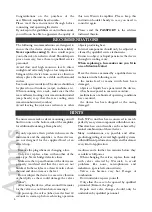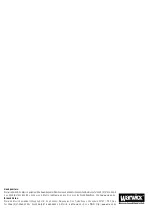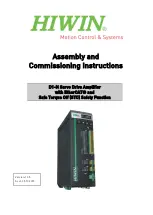
5
Amps
please check
- the position of the Balance Stereo BiAmp control
(Pro Tube IX),
- all stub cables,
- all connections of these cables
and proceed anew by following the guidelines of
the chapter
GETTING STARTED.
Possibly the
problem reveals to be an operational error.
SHOULD YOU FIND YOURSELF ONE DAY WONDERING: "WHY IS THERE NO SOUND COMING
OUT?"
Your new Warwick amplifier is equipped with a
series of circuits to prevent it from destruction in
case of inadequate operating conditions:
Power-up delay:
When the unit is switched on, the
SPEAKER OUT
sockets are activated with a
slight delay to protect the loudspeakers.
Short-circuit:
In the event of a short-circuit at the power amp
outputs, this feature prevents the output stage
transistors from destruction by quickly reducing
current.
Direct current (DC):
This circuit continuously monitors the power amp
output for direct current and protects the
loudspeakers from overload should a transistor
burn out.
HF oscillation:
By switching the power amp off, this safety feature
prevents from damages that could be caused by
frequencies in excess of 20 kHz (feedback, etc.).
Excessive temperatures:
Should the temperature-regulated fan cooler prove
to be insufficient in extreme conditions, this circuit
protects the output stage transistors from
destruction by switching the device off.
Limiter:
The combos CL and CCL are equipped with a
limiter, that limits the poweramp outputs to 150
watts (CL), 250 watts (CCL) in order to protect the
loudspeakers.
Note:
You can recognise that one of these circuits has
been activated as a result of a fault, when the
MUTE
LED glows continuously even though you
have not selected the MUTE mode. In case of a
short-circuit please check the speaker cable. The
amplifier must then be switched off and on again,
to get back into playing mode after having
removed the short-circuit. In any other situation
the amplifier switches automatically back to
playing mode as soon as it detects the fault has
disappeared (e.g. the amplifier has overheated and
cooled down again).
PROTECTIVE CIRCUITS
1. Make sure that loudspeakers capable of
sustaining the load of a bass signal are
connected to the
SPEAKER OUT
sockets.
The speaker cables should meet a cross-
section of at least 2 x 1.5 mm, resp. the
speaker unit should be linked to the
SPEAKER OUT
at the combos.
2. Check that the mains supply has been plugged
in and that all external (effects) units possibly
used are correctly connected and operational.
3. Set the
MASTER
control to zero.
4. Plug your bass guitar into the amplifier's
INPUT
with a shielded line-cable.
5. Press the
POWER
switch to turn the device
on.
6. Switch
MUTE
off and the red LED will
extinguish.
7. Switch the
LIMITER
off (the 2-colored LED
will extinguish).
8. Turn all volume controls of your bass guitar on
to their maximum.
9. Adjust the
GAIN
control until the (loudly)
played bass signal illuminates the
OK
LED.
10. Set the
MASTER
control to the volume you
wish to play at.
11. Adjust the sound that you wish with the
controls and switches described in the
respective chapters FRONT PANEL
CONTROLS.
12. If necessary readjust
GAIN
.
13. Should you seek for a peak limited sound,
activate the
LIMITER
(LED green) and fix its
threshold (LED shifts to red) with GAIN,
respectively with the +/- 0dB ratio of the
graphic EQ (Pro Fet IV).
GETTING STARTED TAKE 12/SWEET 15/CL/CCL/PRO FET II/PRO FET IV

























